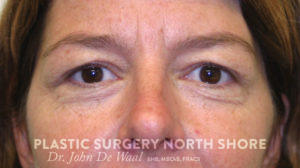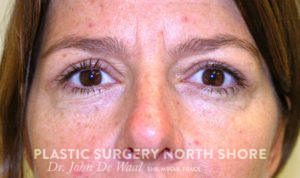Baggy Eyelid Surgery (Blepharoplasty)
The eyes are the focal point of the face; as time passes, they can become a problem area as ageing and genetics take effect. You might notice drooping, deepening wrinkles, bags beneath the eyes or sagging as your eyelid tissues begin to loosen.
Blepharoplasty is an eyelid correction surgery that helps alleviate these issues and restores a youthful appearance to your face and eyes.

What is blepharoplasty surgery?
Blepharoplasty (eyelid correction surgery) is a surgical procedure that removes fat, excess skin and muscle from the upper and lower eyelids. It is one of the most popular cosmetic procedures for facial rejuvenation. We can perform surgery on the lower and/or upper eyelid during the same operation.
Cosmetically, blepharoplasty tightens facial structure, improves muscle tone and eliminates unwanted skin. The end result is a more alert, rested, healthy appearance.
However, blepharoplasty can also improve the functionality of your eyelids. Sagging upper eyelid tissues can impair your vision. Excess skin on the upper eyelids can also lead to skin irritation and excessive strain on your eyebrow muscles.
We use general or local anaesthetic during eyelid surgery, depending on the bespoke treatment plan of the patient. For a full blepharoplasty (upper and lower eyelids) we will use a general anaesthetic throughout.
Benefits of blepharoplasty surgery
The main benefit of blepharoplasty surgery (eyelid surgery) is a rejuvenated, younger appearance around the eye area. Blepharoplasty is a reliable and effective way to get rid of your drooping eyelids and restore self-confidence in your appearance.
Blepharoplasty also offers the following benefits:
- Improved field of vision, including peripheral vision
- Removal of bags to appear less tired
- A smoother, less wrinkled forehead
Many patients report that the blepharoplasty procedure is life-changing! We are proud to help many people feel much happier and more confident after their surgery.
Blepharoplasty is permanent, so the benefits continue long after your operation.
Why do eyelids droop?
Multiple factors contribute to the drooping appearance of your eyelids:
- Skin droop: as the skin ages, it loses elasticity. Gravity causes it to sag. This adds to the appearance of deep wrinkles and folds of eyelid skin.
- Fat herniation: fat that forms a cushion structure deep around the eye can bulge out of position if the structures weaken over time.
- Fat atrophy: the fat of the eye and around the outside of the eye loses its position, firmness and bulk
- Slackening of structures around the eye: your soft tissue and eyelid muscles can also lose tone and start to sag.
- Muscle creases: the action of the muscles around the eye over years produces furrows and creases in the overlying skin. This may also contribute to some flattening of the underlying bone
- Bone resorption: as we age, the bone around the eye partly resorbs. This makes the eye cavity a little larger and gives a ‘hollowed’ appearance
In a surgical blepharoplasty, we place small excisions on your eyelids’ natural creases. We then remove excess skin, fat and muscle. We stitch the eyelids back together with microscope sutures; this creates a very fine line that quickly fades.
Upper Eyelid Blepharoplasty
Upper eyelid surgery mainly involves the removal of excess skin and muscle. We resecure the normal attachment of skin to the muscle, and then stitch it closed. This surgery on its own only requires a local anaesthetic
Lower Eyelid Blepharoplasty
Lower Blepharoplasties are slightly more complex. They involve the manipulation of your lower eyelid fat pad and skin. We place cuts below the lashes of the lower eyelid, then resuspend the tissue and remove or reposition any excess fat. We sometimes tighten the lower eyelid muscles too.
Sometimes we recommend a more comprehensive tightening of your lower lid; this is called a Canthoplasty.
How long does blepharoplasty take?
The surgery takes one to three hours, depending on whether we are operating on one or both of your eyelids.
Each case is individual; we carefully evaluate which components of your eyelids need correction to give you the best result.
A Blepharoplasty is generally a non-invasive surgery, and recovery time is relatively quick. Cold compresses are recommended for 48-72 hours to help reduce swelling and bruising.
- 1-2 days: Bruising and swelling peak after surgery. Your head must also be elevated for several days to reduce swelling
- 4-7 days: Sutures are removed
- 7 days: Any bruising and swelling will subside
- 6 weeks: Any strenuous exercise should be avoided
- 8-10 weeks: Final results will be seen
Following your surgery, you will be given a list recommended steps for eye care to follow. You may have difficulty sleeping the first few days, but this will settle as the healing process continues. Eyes will require regular washing and lubrication with antibiotic creams.
Proper post-operative care is crucial for a quick and safe recovery.
*recovery times are approximate and dependent on the individual and their procedure.
Implications for any surgery are typically unlikely with proper care. However, like all surgeries, there is always a risk of bleeding, infection and bad reactions to anaesthesia.
As blepharoplasty surgery is a common and relatively safe procedure, usually risks and complications are minimal with proper post-operation care and rest.
Upper eyelid surgery risks:
- Bleeding
- Swelling
- Temporary scarring irritation
- Infections
- Eye irritation (especially if prone to skin sensitivity)
Lower eyelid surgery risks:
Lower eyelid surgery is a more significant procedure, and while very safe, does pose a few more risks.
- Drooping of the lower eyelid as scar tissue can cause the lower eyelid to pull downwards. This can be managed with massage and taping.
- Eye Irritation. The eye can be reddened or appear irritated for a prolonged period and may require eyedrops
- Hematoma, as excess bleeding may collect around the eye and need to be removed to avoid distortion
Dr De Waal will inform you of any potential complications during your consultation. You will also be given detailed recommendations for post-operative care to manage pain and heal as quickly as possible.



